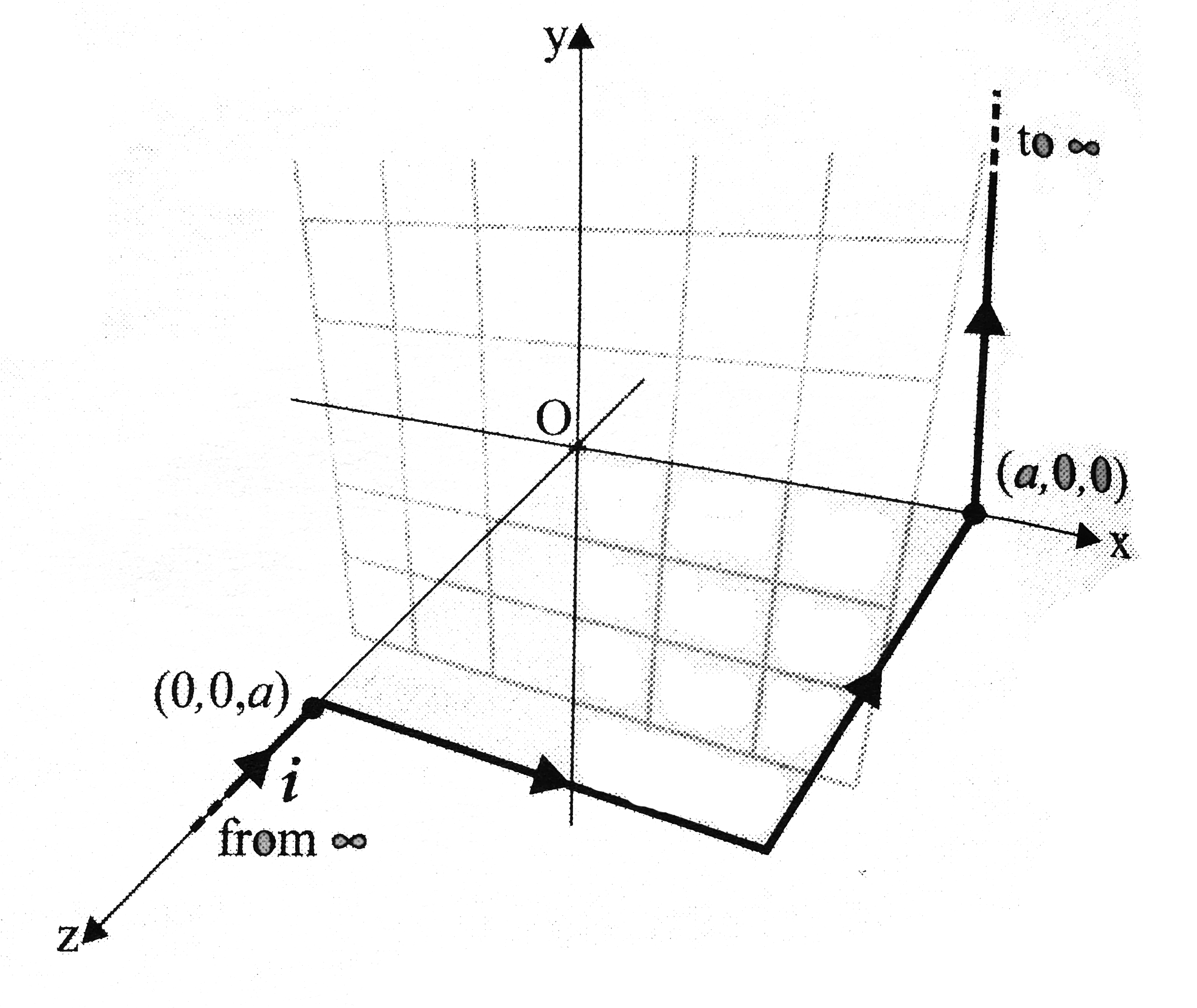A small current element of length 'd l' and carrying current is placed at (1,1,0) and is carrying current in '+z' direction. If magnetic field at origin be →B1 and at point (2,2,0) be →B2 then :
∣∣→B1∣∣=∣∣→B2∣∣
→B1=+→B2
∣∣→B1∣∣=∣∣2→B2∣∣
→B1=−2→B2
The correct Answer is:A
To solve the problem, we need to determine the magnetic fields at two different points due to a small current element. Let's break down the solution step by step.
Step 1: Understand the Position of the Current Element
The current element of length dℓ is located at the point (1,1,0) and is carrying current in the +z direction.
Step 2: Identify the Points of Interest
We need to find the magnetic field at two points:
- At the origin (0,0,0), denoted as →B1
- At the point (2,2,0), denoted as →B2
Step 3: Use the Biot-Savart Law
The magnetic field →B due to a current element Idℓ at a point in space is given by the Biot-Savart Law:
→B=μ04πIdℓ×^rr2
where:
- μ0 is the permeability of free space,
- ^r is the unit vector from the current element to the point where the magnetic field is being calculated,
- r is the distance from the current element to the point.
Step 4: Calculate the Magnetic Field at the Origin →B1
1. Position Vector: The position vector from the current element at (1,1,0) to the origin (0,0,0) is:
→r1=(0−1,0−1,0−0)=(−1,−1,0)
2. Magnitude of r1:
r1=√(−1)2+(−1)2+02=√2
3. Unit Vector ^r1:
^r1=→r1r1=(−1,−1,0)√2=(−1√2,−1√2,0)
4. Cross Product:
The current element dℓ is in the +z direction, so dℓ=(0,0,dℓ).
Idℓ×^r1=(0,0,Idℓ)×(−1√2,−1√2,0)=(Idℓ1√2,−Idℓ1√2,0)
5. Magnetic Field →B1:
→B1=μ0Idℓ4π(Idℓ1√2,−Idℓ1√2,0)2=μ0Idℓ8π(1√2,−1√2,0)
Step 5: Calculate the Magnetic Field at Point (2,2,0) →B2
1. Position Vector: The position vector from the current element at (1,1,0) to the point (2,2,0) is:
→r2=(2−1,2−1,0−0)=(1,1,0)
2. Magnitude of r2:
r2=√(1)2+(1)2+02=√2
3. Unit Vector ^r2:
^r2=→r2r2=(1,1,0)√2=(1√2,1√2,0)
4. Cross Product:
Idℓ×^r2=(0,0,Idℓ)×(1√2,1√2,0)=(−Idℓ1√2,Idℓ1√2,0)
5. Magnetic Field →B2:
→B2=μ0Idℓ4π(−Idℓ1√2,Idℓ1√2,0)2=μ0Idℓ8π(−1√2,1√2,0)
Step 6: Compare →B1 and →B2
From the calculations:
- →B1=μ0Idℓ8π(1√2,−1√2,0)
- →B2=μ0Idℓ8π(−1√2,1√2,0)
Conclusion
The magnitudes of →B1 and →B2 are the same, but their directions are opposite. Thus, we can conclude that:
→B1=−→B2
The current element of length dℓ is located at the point (1,1,0) and is carrying current in the +z direction.
We need to find the magnetic field at two points:
- At the origin (0,0,0), denoted as →B1
- At the point (2,2,0), denoted as →B2
The magnetic field →B due to a current element Idℓ at a point in space is given by the Biot-Savart Law:
- μ0 is the permeability of free space,
- ^r is the unit vector from the current element to the point where the magnetic field is being calculated,
- r is the distance from the current element to the point.
1. Position Vector: The position vector from the current element at (1,1,0) to the origin (0,0,0) is:
→r1=(0−1,0−1,0−0)=(−1,−1,0)
2. Magnitude of r1:
r1=√(−1)2+(−1)2+02=√2
3. Unit Vector ^r1:
^r1=→r1r1=(−1,−1,0)√2=(−1√2,−1√2,0)
4. Cross Product:
The current element dℓ is in the +z direction, so dℓ=(0,0,dℓ).
Idℓ×^r1=(0,0,Idℓ)×(−1√2,−1√2,0)=(Idℓ1√2,−Idℓ1√2,0)
5. Magnetic Field →B1:
→B1=μ0Idℓ4π(Idℓ1√2,−Idℓ1√2,0)2=μ0Idℓ8π(1√2,−1√2,0)
1. Position Vector: The position vector from the current element at (1,1,0) to the point (2,2,0) is:
→r2=(2−1,2−1,0−0)=(1,1,0)
2. Magnitude of r2:
r2=√(1)2+(1)2+02=√2
3. Unit Vector ^r2:
^r2=→r2r2=(1,1,0)√2=(1√2,1√2,0)
4. Cross Product:
Idℓ×^r2=(0,0,Idℓ)×(1√2,1√2,0)=(−Idℓ1√2,Idℓ1√2,0)
5. Magnetic Field →B2:
→B2=μ0Idℓ4π(−Idℓ1√2,Idℓ1√2,0)2=μ0Idℓ8π(−1√2,1√2,0)
From the calculations:
- →B1=μ0Idℓ8π(1√2,−1√2,0)
- →B2=μ0Idℓ8π(−1√2,1√2,0)
The magnitudes of →B1 and →B2 are the same, but their directions are opposite. Thus, we can conclude that:
Topper's Solved these Questions
- TEST PAPERSBOOK - ALLENCHAPTER - TEST PAPERSEXERCISE - PAPER 3
99 Videos
- TEST PAPERSBOOK - ALLENCHAPTER - TEST PAPERSEXERCISE - Part-1 Physics
15 Videos
- TEST PAPERSBOOK - ALLENCHAPTER - TEST PAPERSEXERCISE - MATHS
14 Videos
- TEST PAPER 4BOOK - ALLENCHAPTER - TEST PAPER 4EXERCISE - PHYSICS
44 Videos
- UNIT & DIMENSIONS, BASIC MATHS AND VECTOR BOOK - ALLENCHAPTER - UNIT & DIMENSIONS, BASIC MATHS AND VECTOR EXERCISE - Exercise (J-A)
7 Videos
Similar Questions
Knowledge Check
The magnetic force per unit length on a wire carrying a current of 10 A and making an angle of 45∘ with the direction of a uniform magnetic field of 0.20 T is
A2√2Nm−1B2√2Nm−1C√22Nm−1D4√2Nm−1The magnetic force →F on a current carrying conductor of length I in an external magnetic field →B is given by
AI×→B→lB→l×→BICI(→l×→B)Dl2→l×→B
a straight wire current element is carrying current 100 A as shown in figure. the magnitude of magnetic field at a point P.

View SolutionA straight wire of diametre 0.5 mm carrying a current of 1 A is replaced by another wire of 1mm diametre carrying same current. The strenth of magnetic field far away is
View SolutionThe direction of force on a current carrying conductor in a magnetic field is given by
View SolutionFind →B at the origin due to the long wire carrying current I.

View SolutionTwo parallel wire carrying equal currents in opposite directions are placed at x=±a parralel to y-axis with z=0. Magnetic field at origin O is B1 and at P(2a,0,0)isB2. Then, the ratio B1/B2 is
View SolutionThe magnetic field ¯¯¯¯¯dB due to a small current element ¯¯¯dl at a distance →r and carrying current 'I' is
View Solution

